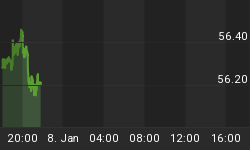On Monday, March 20th, I issued a strong, unequivocal sell recommendation on the stock market. As I explained at the time, the decision to do this was predicated on an amalgam of fundamental, technical and gut considerations. Very prominent among these was my growing bearishness on longer-dated, open-market interest rates. In turn, my bond-market views were heavily influenced by rapidly growing concerns of both a fundamental and technical nature.
On balance, I am slightly ahead on my sell-stocks recommendation, and considering it was made going on a month ago, I feel pretty good about it. On a net basis, stocks have done little but back and fill, which means that thus far, the recommendation has worked out the way I would have hoped. To wit: people have had time to react to it in an orderly setting, without having been hurt in the process. In this regard, "hurt" means having prices move strongly against them to the upside.
Incidentally, I would not have done this unless I thought equity prices had at least a 5% to 10% downside vulnerability from the levels prevailing at the time, with emphasis here placed on the "at least" part!
But my pessimism on the stock market is not the subject at hand. Instead, it is what has happened to bond prices that I want to discuss.
With the great interest-rate "conundrum" that Greenspan had been pondering for a long time, it occurred to me that many people might have forgotten the magnitude of negative price volatility of which longer-dated, fixed-rate debt obligations were capable under adverse circumstances. Therefore, on March 31st, I penned a short missive addressing the subject of bond-market total return.
(As an aside, Greenspan and his highly, highly questionable monetary policy of recent years created the conundrum over which he so often mused. Uncle Al, Wall Street's pal, knew it, too! But as the saying goes, "timing is everything," and Greenspan got out just in time, before all hell broke loose at the longer end of the Treasury yield curve. To put icing on the cake, at least over the short run, Greenspan can blame Bernanke for what has happened. This is while Uncle Al sets out to establish his legacy, concurrently pimping huge speaking fees and a multi-million-dollar book deal!)
When I wrote my late-March piece, the 10-year note the Treasury had auctioned as part of its February refunding operation already had sunk to a negative total return of 1.89% (comprised of an income accrual of +0.54%, netted against a loss in principal value of 2.43%.) In a world of highly leveraged hedge-fund carry trades and the like, this was pretty ugly, as well as potentially dangerous. Dangerous in the sense that large sell-offs over a short period of time ran a risk of margin calls, thereby exacerbating the sell-off.
And while I cannot prove this is what has taken place, the additional large net decline over the last few days suggests it could have. For instance, the 10-year note (Treasury 4.50s of 2/15/2016) finished yesterday at a yield of 5.05%, a whopping 51 basis points higher than the 4.54% yield at which it was auctioned not very long ago. As for the 30-year bond auctioned in February (Treasury 4.50s of 2/15/2036), it ended yesterday at 5.11%, 58 basis points higher in yield than its February auction price. And because of the 30-year bond's much longer duration, its price has really been spanked in the open market.
To put this in context through yesterday, the 10-year note's total return from the time it was paid for in mid-February through yesterday's close was minus 3.21% (income accrual of +72 basis points, netted against a loss in principal of 3.93%). As for the 30-year bond, its total return was a stunning minus 8.15% (income accrual of 72 basis points, netted against a loss of principal of 8.87%... Yes, you read correctly, that is minus 8.87%!).
Is the bloodletting over? I rather doubt it, but that, too, is a discussion for a different time and place. In the meantime, the following link will take readers to my March 31st missive that helps supplement the points made here. That piece was entitled, "The Potential Horror of Fixed-Income Total Return" and can be read by following this link: www.gillespieresearch.com/cgi-bin/s/article/id=800
















